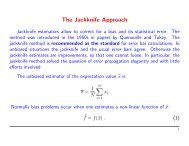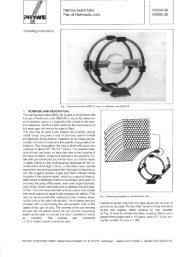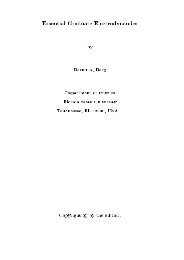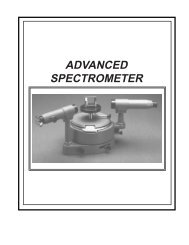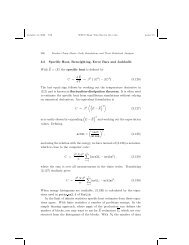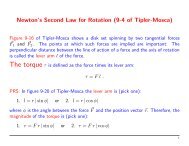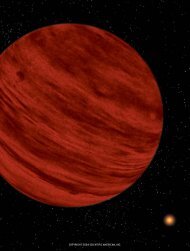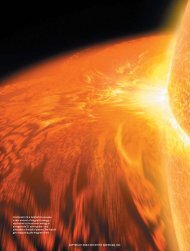The Stellar Dynamo - Scientific American Digital
The Stellar Dynamo - Scientific American Digital
The Stellar Dynamo - Scientific American Digital
- No tags were found...
You also want an ePaper? Increase the reach of your titles
YUMPU automatically turns print PDFs into web optimized ePapers that Google loves.
Intensity of Calcium Emission Lines<br />
0.4<br />
●<br />
0.35 ● ● ● ● ● ● ● ● ● ● ● ●<br />
● ●<br />
● ● ● ● ● ●<br />
●<br />
●<br />
● ● ●<br />
● ●<br />
● ● ● ● ● ● ● ● ●<br />
0.3<br />
0.3<br />
0.25<br />
0.2<br />
0.18<br />
0.16<br />
0.14<br />
●<br />
Young star, HD 20686, variable cycle<br />
Mature star, HD 4628, 8.6-year cycle<br />
● ● ●<br />
●<br />
● ● ● ●<br />
Mature star, HD 14376, flat<br />
● ● ●<br />
●<br />
●<br />
●<br />
●<br />
● ● ● ● ● ● ● ● ● ● ● ● ● ●<br />
● ●<br />
● ●<br />
● ● ● ●<br />
●<br />
●<br />
●<br />
● ●<br />
● ● ● ● ● ●<br />
● ●<br />
● ● ● ● ● ● ● ● ● ● ● ● ● ● ●<br />
● ● ● ● ● ● ●<br />
1966 1970 1975 1980<br />
1985 1990 1995 2000<br />
INTERANNUAL MAGNETIC VARIABILITY of stars over the years is detected by way of violet calcium<br />
emission lines. Here activity from three nearby stars reveals the likely states of our own sun: the<br />
variable magnetic cycles of a young star (top); the steady cycles of a star at an age comparable to<br />
our sun’s (middle); and the subsidence of a sunlike star into a Maunder-type minimum phase<br />
(bottom). <strong>The</strong> magnetic, and therefore sunspot, activity of other stars indicates that our sun is<br />
capable of far greater variability than it has shown in the past century.<br />
Year<br />
over a cycle: the bright plages overwhelm<br />
the dark sunspots. (Presumably,<br />
as the sun brightens and darkens, its total<br />
energy is temporarily channeled into<br />
different reservoirs—kinetic, magnetic,<br />
thermal or potential.) During the past 24<br />
years of satellite observations, the sun’s<br />
total energy output has varied roughly<br />
0.1 percent between a brighter, magnetically<br />
active phase and a fainter, quiet one.<br />
Because of the brevity of the satellite<br />
records, we do not know the variability<br />
of the sun’s brightness over decades.<br />
Richard Willson and his colleagues at<br />
Columbia University’s Center for Climate<br />
Systems Research recently found a<br />
slight, 0.05 percent increase in brightness<br />
at the observed solar minima in 1986<br />
and 1996. Finding a longer-term value<br />
for brightness variability, however, is vital<br />
to evaluating the sun’s influence on<br />
Earth. One possible way to answer this<br />
question is to examine “star spot” cycles<br />
on other stars.<br />
It is not easy to map the features on<br />
the surface of stars. But as magnetic<br />
fields heat the outer layers of a star’s atmosphere,<br />
they radiate the energy in certain<br />
spectral lines. For example, on our<br />
sun, the intensity of the two violet emission<br />
lines of calcium (having wavelengths<br />
of 396.7 and 393.4 nanometers)<br />
closely follows the strength and extent<br />
of the magnetic fields. Variations in<br />
these lines thus give us a measure of the<br />
changing surface magnetism of a star.<br />
At Mount Wilson Observatory in<br />
1966, Olin C. Wilson began a program<br />
of measuring the magnetic activity of<br />
roughly 100 so-called main-sequence<br />
stars—those that, like the sun, are burning<br />
hydrogen. (When the hydrogen runs<br />
out, a star expands into a red giant.)<br />
Most of these stars show obvious signs<br />
of magnetic activity, by way of variations<br />
in their violet calcium emission<br />
THE AUTHORS<br />
lines. <strong>The</strong> fluctuations vary greatly in<br />
amplitude and duration, depending primarily<br />
on the age and mass of the star.<br />
All these stars have a dynamo number,<br />
D, higher than the critical value required<br />
for sustaining magnetic fields. For<br />
a young star of one or two billion years,<br />
the rotation period is fast, roughly 10<br />
to 15 days. <strong>The</strong> resulting high value of<br />
D means that these young stars have erratic<br />
fluctuations in magnetic activity<br />
over intervals as short as two years and<br />
no well-defined cycles. <strong>The</strong> fluctuations<br />
sometimes repeat, however, having periods<br />
between two and 20 years or so<br />
that lengthen with age.<br />
But as a star ages, it slows down—<br />
because its angular momentum is carried<br />
off by the magnetic wind—and D falls.<br />
<strong>The</strong>n a consistent dynamo cycle begins<br />
to appear, with a period of about six to<br />
seven years and sometimes even with<br />
two independent periods. Later on—for<br />
an even lower D—one period starts to<br />
dominate, lengthening with age from<br />
eight to 14 years. In addition, there are<br />
occasional Maunder minima. If rotation<br />
were to slow further, in the very oldest<br />
stars, we predict that the magnetic field<br />
should be steady. <strong>The</strong> Wilson sample<br />
contains a few very old stars, but they<br />
still show cycles, indicating that the<br />
steady dynamo would not be reached in<br />
10 billion years—soon after which they<br />
will expand into red giants.<br />
To focus on the solar dynamo, Baliunas<br />
and her collaborators restricted<br />
Wilson’s broad sample of stars to those<br />
similar to our sun in mass and age. That<br />
group currently comprises 10- to 20-year<br />
records of 150 stars, depending on the<br />
criteria defining similarity to the sun.<br />
Many of these stars show prominent cycles<br />
similar in amplitude and period to<br />
those of the sun. About one quarter of<br />
ELIZABETH NESME-RIBES, SALLIE L. BALIUNAS and DMITRY SOKOLOFF all have been active<br />
in unraveling connections between the sun’s variations and Earth’s climate. Nesme-<br />
Ribes, who recently passed away, was an astronomer at the Paris Observatory and the National<br />
Center for <strong>Scientific</strong> Research in France. Apart from studying the solar dynamo, she<br />
conducted extensive searches into the 17th-century archives on sunspots at her home institution.<br />
Baliunas is a scientist at the Harvard-Smithsonian Center for Astrophysics in Cambridge,<br />
Mass. She observes the variations of sunlike stars at the Mount Wilson Observatory<br />
in Pasadena, Calif. Sokoloff is professor of mathematics in the department of physics at<br />
Moscow State University in Russia.<br />
MOUNT WILSON OBSERVATORY HK PROJECT; PETER SAMEK Slim Films<br />
40 SCIENTIFIC AMERICAN THE SECRET LIVES OF STARS<br />
COPYRIGHT 2004 SCIENTIFIC AMERICAN, INC.



